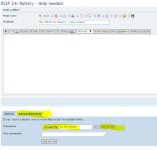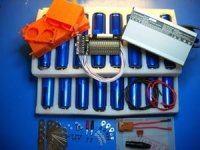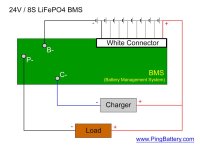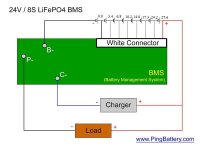Hello all,
Just wanted to introduce myself and explain my reason for registering here.
I live in Canada and am a cave diver, have been for many years and what brings me to your wonderful site is a project I am working on that could use a bit of input from an electrically educated group.
I have used the search function but do not find any clear answers to my questions.
So I hope you too will find my project of interest and help me with a few points of information.
I am looking to replace my SLA battery's in my DPV (Diver Propulsion Vehicle) “Underwater scooter”
with LiFePO4 cells for longer run times, higher cycle life. We are finding we cannot get enough range from our 24v - 18ah SLA's and I want to move up to a 24v 30ah Lithium pack.
I am planning on using Headway 40152S cells in a 4 x4 - 8S2P arrangement, with a Signalab V5 BMS.
The reason I am posting here now is to ask if someone can confirm my wiring configuration of the pack. I have attached drawings of how I think it needs to be wired to achieve the desired voltage/amperage and want to know if I am on the right track before continuing with the project.
(I am only in the fact gathering stage, and not building at the moment)
Any help would be greatly appreciated as well as any other pertinent information about building a battery of this type.
Thank you,
AJM
EDIT: I am unable to attach my diagrams for some reason, if able to assist PLEASE contact me and I will send the diagrams to you.
Just wanted to introduce myself and explain my reason for registering here.
I live in Canada and am a cave diver, have been for many years and what brings me to your wonderful site is a project I am working on that could use a bit of input from an electrically educated group.
I have used the search function but do not find any clear answers to my questions.
So I hope you too will find my project of interest and help me with a few points of information.
I am looking to replace my SLA battery's in my DPV (Diver Propulsion Vehicle) “Underwater scooter”
with LiFePO4 cells for longer run times, higher cycle life. We are finding we cannot get enough range from our 24v - 18ah SLA's and I want to move up to a 24v 30ah Lithium pack.
I am planning on using Headway 40152S cells in a 4 x4 - 8S2P arrangement, with a Signalab V5 BMS.
The reason I am posting here now is to ask if someone can confirm my wiring configuration of the pack. I have attached drawings of how I think it needs to be wired to achieve the desired voltage/amperage and want to know if I am on the right track before continuing with the project.
(I am only in the fact gathering stage, and not building at the moment)
Any help would be greatly appreciated as well as any other pertinent information about building a battery of this type.
Thank you,
AJM
EDIT: I am unable to attach my diagrams for some reason, if able to assist PLEASE contact me and I will send the diagrams to you.








